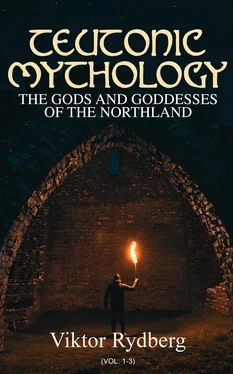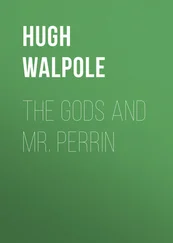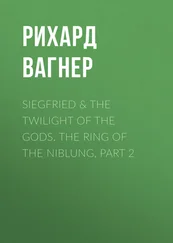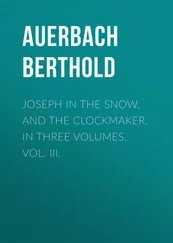Viktor Rydberg - Teutonic Mythology - The Gods and Goddesses of the Northland (Vol. 1-3)
Здесь есть возможность читать онлайн «Viktor Rydberg - Teutonic Mythology - The Gods and Goddesses of the Northland (Vol. 1-3)» — ознакомительный отрывок электронной книги совершенно бесплатно, а после прочтения отрывка купить полную версию. В некоторых случаях можно слушать аудио, скачать через торрент в формате fb2 и присутствует краткое содержание. Жанр: unrecognised, на английском языке. Описание произведения, (предисловие) а так же отзывы посетителей доступны на портале библиотеки ЛибКат.
- Название:Teutonic Mythology: The Gods and Goddesses of the Northland (Vol. 1-3)
- Автор:
- Жанр:
- Год:неизвестен
- ISBN:нет данных
- Рейтинг книги:4 / 5. Голосов: 1
-
Избранное:Добавить в избранное
- Отзывы:
-
Ваша оценка:
- 80
- 1
- 2
- 3
- 4
- 5
Teutonic Mythology: The Gods and Goddesses of the Northland (Vol. 1-3): краткое содержание, описание и аннотация
Предлагаем к чтению аннотацию, описание, краткое содержание или предисловие (зависит от того, что написал сам автор книги «Teutonic Mythology: The Gods and Goddesses of the Northland (Vol. 1-3)»). Если вы не нашли необходимую информацию о книге — напишите в комментариях, мы постараемся отыскать её.
One of Rydberg's mythological theories developed in this book is that of a vast World Mill which rotates the heavens, which he believed was an integral part of Old Norse mythic cosmology.
Teutonic Mythology: The Gods and Goddesses of the Northland (Vol. 1-3) — читать онлайн ознакомительный отрывок
Ниже представлен текст книги, разбитый по страницам. Система сохранения места последней прочитанной страницы, позволяет с удобством читать онлайн бесплатно книгу «Teutonic Mythology: The Gods and Goddesses of the Northland (Vol. 1-3)», без необходимости каждый раз заново искать на чём Вы остановились. Поставьте закладку, и сможете в любой момент перейти на страницу, на которой закончили чтение.
Интервал:
Закладка:
In ancient times arrangements were made for spreading the knowledge of the good runes among all kinds of beings. Odin taught them to his own clan; Dáinn taught them to the Elves; Dvalinn among the dwarfs; Ásvinr (see No. 88) among the giants (Havam., 143). Even the last-named became participators in the good gift, which, mixed with sacred mead, was sent far and wide, and it has since been among the Asas, among the Elves, among the wise Vans, and among the children of men (Sigrdr., 18). The above-named Dvalinn, who taught the runes to his clan of ancient artists, is the father of daughters, who, together with dises of Asa and Vana birth, are in possession of bjargrúnar , and employ them in the service of man (Fafnism., 13).
To men the beneficent runes came through the same god who as a child came with the sheaf of grain and the tools to Scandia. Hence the belief current among the Franks and Saxons that the alphabet of the Teutons, like the Teutons themselves, was of northern origin. Rigsthula expressly presents Heimdal as teaching runes to the people whom he blessed by his arrival in Midgard. The noble-born are particularly his pupils in runic lore. Of Heimdal's grandson, the son of Jarl Borgar, named Kon-Halfdan, it is said:
| En Konr ungr kunni runar, æfinrunar ok alldrrunar. Meir kunni hann monnum bjarga, eggjar deyfa, ægi legia, klok nam fugla, kyrra ellda, sæva ok svefia, sorgir lægia. | But Kon the young taught himself runes, runes of eternity and runes of earthly life. Then he taught himself men to save, the sword-edge to deaden, the sea to quiet, bird-song to interpret, fires to extinguish, to soothe and comfort, sorrows to allay. |
The fundamental character of this rune-lore bears distinctly the stamp of nobility. The runes of eternity united with those of the earthly life can scarcely have any other reference than to the heathen doctrines concerning religion and morality. These were looked upon as being for all time, and of equal importance to the life hereafter. Together with physical runes with magic power—that is, runes that gave their possessors power over the hostile forces of nature—we find runes intended to serve the cause of sympathy and mercy.
27.
SORCERY THE REVERSE OF THE SACRED RUNES. GULLVEIG-HEIDR, THE SOURCE OF SORCERY. THE MORAL DETERIORATION OF THE ORIGINAL MAN.
Table of Contents
But already in the beginning of time evil powers appear for the purpose of opposing and ruining the good influences from the world of gods upon mankind. Just as Heimdal, "the fast traveller," proceeds from house to house, forming new ties in society and giving instruction in what is good and useful, thus we soon find a messenger of evil wandering about between the houses in Midgard, practising the black art and stimulating the worst passions of the human soul. The messenger comes from the powers of frost, the enemies of creation. It is a giantess, the daughter of the giant Hrimnir (Hyndlulj., 32), known among the gods as Gulveig and by other names (see Nos. 34, 35), but on her wanderings on earth called Heidr . "Heid they called her (Gulveig) when she came to the children of men, the crafty, prophesying vala, who practised sorcery ( vitti ganda ), practised the evil art, caused by witchcraft misfortunes, sickness, and death ( leikin , see No. 67), and was always sought by bad women." Thus Völuspa describes her. The important position Heid occupies in regard to the corruption of ancient man, and the consequences of her appearance for the gods, for man, and for nature (see below), have led Völuspa's author, in spite of his general poverty of words, to describe her with a certain fulness, pointing out among other things that she was the cause of the first war in the world. That the time of her appearance was during the life of Borgar and his son shall be demonstrated below.
In connection with this moral corruption, and caused by the same powers hostile to the world, there occur in this epoch such disturbances in nature that the original home of man and culture—nay, all Midgard—is threatened with destruction on account of long, terrible winters. A series of connected myths tell of this. Ancient artists—forces at work in the growth of nature—personifications of the same kind as Rigveda's Ribhus, that had before worked in harmony with the gods, become, through the influence of Loke, foes of Asgard, their work becoming as harmful as it before was beneficent, and seek to destroy what Odin had created (see Nos. 111 and 112). Idun, with her life-renewing apples, is carried by Thjasse away from Asgard to the northernmost wilderness of the world, and is there concealed. Freyja, the goddess of fertility, is robbed and falls into the power of giants. Frey, the god of harvests, falls sick. The giant king Snow and his kinsmen Thorri (Black Frost), Jökull (the Glacier), &c., extend their sceptres over Scandia.
Already during Heimdal's reign, after his protégé Borgar had grown up, something happens which forebodes these terrible times, but still has a happy issue.
28A.
HEIMDAL AND THE SUN-DIS (Dis-goddess).
Table of Contents
In Saxo's time there was still extant a myth telling how Heimdal, as the ruler of the earliest generation, got himself a wife. The myth is found related as history in Historia Danica , pp. 335–337. Changed into a song of chivalry in middle age style, we find it on German soil in the poem concerning king Ruther.
Saxo relates that a certain king Alf undertook a perilous journey of courtship, and was accompanied by Borgar. Alf is the more noble of the two; Borgar attends him. This already points to the fact that the mythic figure which Saxo has changed into a historical king must be Heimdal, Borgar's co-father, his ruler and fosterer, otherwise Borgar himself would be the chief person in his country, and could not be regarded as subject to anyone else. Alf's identity with Heimdal is corroborated by "King Ruther," and to a degree also by the description Saxo makes of his appearance, a description based on a definite mythic prototype. Alf, says Saxo, had a fine exterior, and over his hair, though he was young, a so remarkably white splendour was diffused that rays of light seemed to issue from his silvery locks ( cujus etiam insignem candore cæsariem tantus comæ decor asperierat, ut argenteo crine nitere putaretur ). The Heimdal of the myth is a god of light, and is described by the colour applied to pure silver in the old Norse literature to distinguish it from that which is alloyed; he is hvíti áss (Gylfag., 27) and hvítastr ása (Thrymskvida, 5); his teeth glitter like gold, and so does his horse. We should expect that the maid whom Alf, if he is Heimdal, desires to possess belongs like himself to the divinities of light. Saxo also says that her beauty could make one blind if she was seen without her veil, and her name Alfhild belongs, like Alfsol, Hild, Alfhild Solglands, Svanhild Guldfjæder, to that class of names by which the sundises, mother and daughter, were transferred from mythology to history. She is watched by two dragons. Suitors who approach her in vain get their heads chopped off and set up on poles (thus also in "King Ruther"). Alf conquers the guarding dragons; but at the advice of her mother Alfhild takes flight, puts on a man's clothes and armour, and becomes a female warrior, fighting at the head of other Amazons. Alf and Borgar search for and find the troop of Amazons amid ice and snow. It is conquered and flies to "Finnia," Alf and Borgar pursue them thither. There is a new conflict. Borgar strikes the helmet from Alfhild's head. She has to confess herself conquered, and becomes Alf's wife.
In interpreting the mythic contents of this story we must remember that the lad who came with the sheaf of grain to Scandia needed the help of the sun for the seed which he brought with him to sprout, before it could give harvests to the inhabitants. But the saga also indicates that the sun-dis had veiled herself, and made herself as far as possible unapproachable, and that when Heimdal had forced himself into her presence she fled to northern ice-enveloped regions, where the god and his foster-son, sword in hand, had to fetch her, whereupon a happy marriage between him and the sun-dis secures good weather and rich harvests to the land over which he rules. At the first glance it might seem as if this myth had left no trace in our Icelandic records. This is, however, not the case. Its fundamental idea, that the sun at one time in the earliest ages went astray from southern regions to the farthest north and desired to remain there, but that it was brought back by the might of the gods who created the world, and through them received, in the same manner as Day and Night, its course defined and regularly established, we find in the Völuspa strophe, examined with so great acumen by Julius Hoffory, which speaks of a bewilderment of this kind on the part of the sun, occurring before it yet "knew its proper sphere," and in the following strophe, which tells how the all-holy gods thereupon held solemn council and so ordained the activity of these beings, that time can be divided and years be recorded by their course. Nor is the marriage into which the sun-dis entered forgotten. Skaldskaparmal quotes a strophe from Skule Thorsteinson where Sol [12]is called Glenr's wife. That he whom the skald characterises by this epithet is a god is a matter of course. Glenr signifies "the shining one," and this epithet was badly chosen
Читать дальшеИнтервал:
Закладка:
Похожие книги на «Teutonic Mythology: The Gods and Goddesses of the Northland (Vol. 1-3)»
Представляем Вашему вниманию похожие книги на «Teutonic Mythology: The Gods and Goddesses of the Northland (Vol. 1-3)» списком для выбора. Мы отобрали схожую по названию и смыслу литературу в надежде предоставить читателям больше вариантов отыскать новые, интересные, ещё непрочитанные произведения.
Обсуждение, отзывы о книге «Teutonic Mythology: The Gods and Goddesses of the Northland (Vol. 1-3)» и просто собственные мнения читателей. Оставьте ваши комментарии, напишите, что Вы думаете о произведении, его смысле или главных героях. Укажите что конкретно понравилось, а что нет, и почему Вы так считаете.











